|
| Links | email Sam Droege sdroege@usgs.gov for a excel spreadsheet of ID information for the Eastern Melandrena males
- Hosts
|
80x5 -
240x3 -
240x4 -
320x1 -
320x2 -
320x3 -
640x1 -
640x2
Set display option above.
Click on
images to enlarge. |
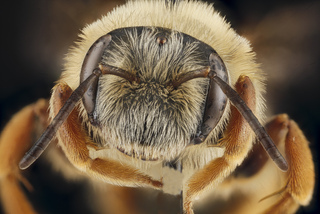
© Copyright source/photographer
· 9
Andrena commoda, female, face |
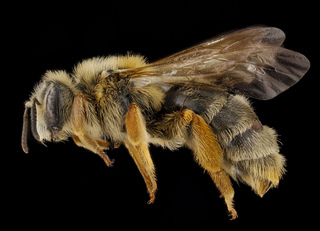
© Copyright source/photographer
· 9
Andrena commoda, female, side |
|
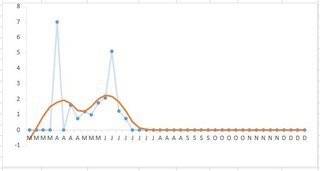
© Copyright source/photographer
· 9
Andrena commoda, Mid-Atlantic Phenology |
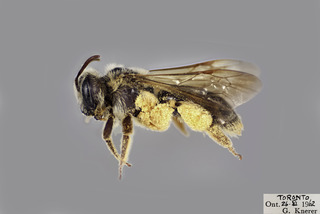
© Copyright Laurence Packer 2014
· 7
Andrena commoda FEM CFP comp |
|
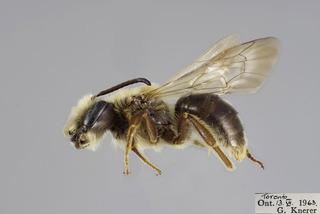
© Copyright Laurence Packer 2014
· 7
Andrena commoda MALE CFP comp |
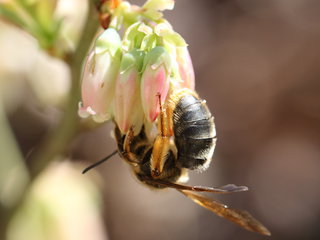
Michael Veit · 6
Andrena commoda, f on Vaccinium -- |
|
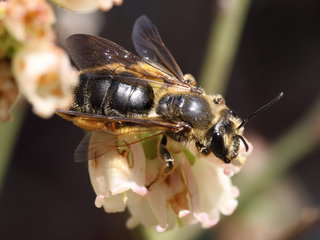
Michael Veit · 6
Andrena commoda, f on Vaccinium -- |
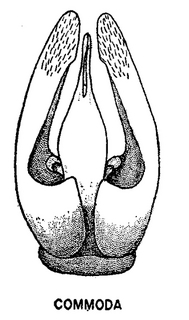
© Copyright source/photographer
· 1
Andrena commoda, male, genital armature |
|
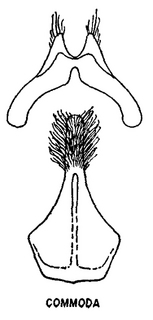
© Copyright source/photographer
· 1
Andrena commoda, male, sternal plates 7 and 8 |
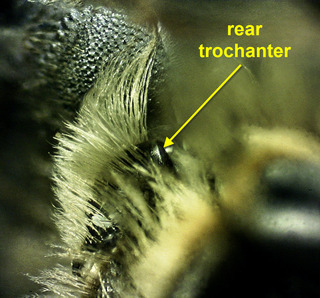
Deana Crumbling · 1
Andrena commoda female, incomplete flocculus |
|
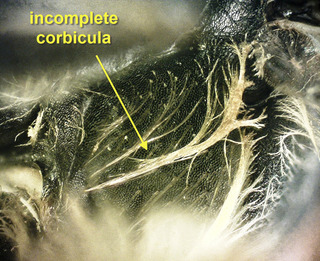
© Copyright Deana Crumbling 2010
· 1
Andrena commoda, female, incomp corbicula label |
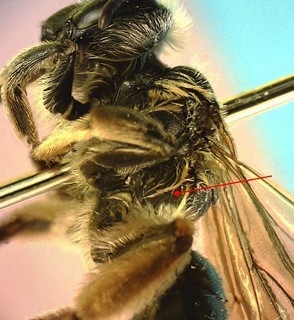
© Copyright Deana Crumbling 2010
· 1
Andrena commoda, female. incomplete corbicula arrow |
|
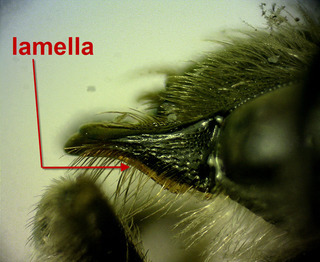
© Copyright Deana Crumbling 2010
· 1
Andrena commoda, female, mandible lamella |
|
Overview |
Reprinted with permission of the American Entomological Society from:
Bouseman, J. K., LaBerge, W. E. 1978. A revision of the bees of the genus Andrena of the Western Hemisphere. Part IX. Subgenus Melandrena. Transactions of the American Entomological Society 104: 275-390.
Please report text errors to: leah at discoverlife dot org.
Andrena commoda is a relatively small, wide spread, northern species of the vicina group. The female of commoda can be recognized by the terga being dulled by fine dense shagreening, the often red or orange hind tibiae and basitarsi, the pale vestiture, and the entire labral process usually lacking transverse basal striae. The male can be recognized by the relatively long first flagellar segment (usually one and one-half times as long as the second or longer) and the short antennae, the dull, shagreened terga, the usual lack of transverse striae at the base of the labral process, and the frequently ferruginous tarsi and hind tibiae.
FEMALE. MEASUREMENTS AND RATIOS. — N = 20; length, 9-13 mm; width, 2.5-3.5 mm; wing length, M = 4.34 ± 0.162 mm; FL/FW, M = 0.96 ± 0.004; FOVL/FOVW, M = 3.24 ± 0.033.
INTEGUMENTAL COLOR. — Generally black except as follows: mandible with apical third or more rufescent (occasionally entirely so); flagellar segments below reddish-brown, occasionally scape and flagellar segment 1 or segments 1 and 2 orange Mow; tegula translucent, dark rufescent; wing membranes slightly infumate, yellowish, veins orange or red to reddish-brown; terga with apical areas often translucent brown apically; sterna with apical areas hyaline, clear to yellow; tarsi and hind tibia reddish-brown to bright orange, in specimens with bright orange hind tibiae the basal leg segments usually rufescent.
STRUCTURE. — Antenna as in vicina but flagellar segment 1 as long as or slightly longer than segments 2 and 3. Eyes each about four times as long as broad, inner margins parallel to slightly converging toward vertex. Mandible, malar space and galea as in vicina. Maxillary palpus as in vicina but segmental ratio about as 1.0:1.0:0.9:0.6:0.6:0.6. Labial palpus as in vicina but ratio about as 1.0:0.6:0.4:0.4. Labral process entire, trapezoidal to rounded, depressed basally without transverse striae or rarely one or two at extreme base; labrum below process usually with several short longitudinal cristae, not sulcate, finely punctate near process. Clypeus as in vicina but median impunctate line narrow, occasionally obliterated posteriorly, surface shiny except in posterior third or less where finely shagreened. Supraclypeal area, face above antennal fossae and facial fovea as in vicina. Vertex as in vicina but usually slightly less than twice as tall as diameter of lateral ocellus (about as 7:4). Genal area as in vicina.
Thoracic form and sculpturing as in vicina except as follows: propodeum with dorsal enclosure usually smooth, with short rugulae at extreme base, tessellate, rarely with irregular fine rugulae over basal half or more; propodeum with dorsal surface outside of enclosure and posterior surface with small punctures obscured by dense tessellation and not roughening surface. Wing venation, tibial spurs and tarsal claws as in vicina.
metasomal terga 1-4 sculptured as in vicina but punctures more variable, on tergum 2 basal area punctures separated by one to two puncture widths in some specimens to two to four puncture widths in most specimens; surfaces of terga dulled by fine, dense, reticular shagreening, apical areas moderately shiny but shagreening present. Pygidial plate V-shaped, apex rounded but narrow, without raised internal triangular area. Sterna sculptured as in vicina.
VESTITURE. — Generally pale ochraceous to ochraceous but inner surfaces tarsi pale yellow and facial foveal hair while. Form and distribution of hairs as in vicina but dorsal thoracic hairs relatively short and sparse and terga 2-4 with weak apical pale fasciae interrupted medially on terga 2 and 3.
MALE. MEASUREMENTS AND RATIOS. — N = 20; length, 9-12 mm; width, 2.0-3.5 mm; wing length, M = 3.81 ± 0.227 mm; FL/FW, M = 0.91 ± .006; FS1/FS2, M = 1.59 ± 0.026.
INTEGUMENTAL COLOR. — Black except as follows: mandible with apical third or more rufescent; flagellum below dark reddish-brown, segment 1 or segments 1 and 2 often bright orange below (occasionally only tip of segment 1 orange); tegula translucent, ferruginous; wing membranes slightly infumate, yellowish, veins red to reddish-brown; terga with apical areas translucent at least apically, brown; sterna 2-5 hyaline apically, with rufescent reflections basally; distitarsi rufescent to bright orange; basitarsi reddish-brown to bright orange; tibiae brown to orange (especially hind tibia often orange); basal leg segments brown, often with rufescent reflections; tibial spurs testaceous.
STRUCTURE. — Antenna short, in repose barely reaching scutellum or not quite; scape length equals first three flagellar segments or almost; flagellar segment 1 about one and one-half times as long as segment 2 and distinctly longer than segment 3; segment 2 quadrate or broader than long; segments 3-10 slightly longer than broad. Eyes, mandible, malar area and galea as in female. Maxillary palpus as in vicina but segmental ratio about as 1.0:1.0:0.6:0.6:0.4:0.6. Labial palpus as in vicina but ratio about 1.0:0.6:0.4:0.5. Labral process bidentate, thickened near apex, basal depression without transverse striae (two specimens have one or two weak striae at extreme base), shiny; labrum apical to process punctate, not sulcate nor cristate. Clypeus with small round punctures separated by a half a puncture width or slightly more, without median impunctate line; surface usually dulled by fine shagreening at least in basal half and often over entire surface. Supraclypeal area, face above antennal fossae, vertex and genal area as in female.
Thoracic form and sculpturing as in vicina but propodeum with dorsal enclosure with short irregular rugulae usually only in basal half or less (rarely over most of enclosure); propodeal dorsal surface outside of enclosure and posterior surface roughened by coarse punctures and tessellation. Wing venation, tibial spurs and tarsal claws as in vicina.
Metasomal terga sculptured as in female. Tergum 7 with narrow, acutely pointed, shiny pygidial area. Sterna 2-5 sculptured as in vicina. Sternum 6 with apical margin gently concave.
Terminalia as in figures 94-98; note sternum 7 with apical emargination extremely deep and narrow and sternum 8 with apical lobe narrow as in hilaris.
VESTITURE. — Generally pale ochraceous to ochraceous but inner surfaces tarsi pale yellow. Form and distribution of hair as in vicina but terga 2-4 with weak apical pale fasciae interrupted medially on terga 2 and 3.
Reprinted with permission from: Mitchell, T.B. 1960. Bees of the Eastern United States. North Carolina Agricultural Experiment Station Technical Bulletin No. 141.
FEMALE. — Length 11 mm.; clypeus moderately convex, projecting nearly one-half below suborbital line, somewhat shining, uniformly, closely, deeply and rather finely punctate, without a median impunctate line; facial foveae broad, occupying above about two-thirds of area between eyes and lateral ocelli, covered with whitish tomentum; space be tween margin of vertex and lateral ocelli slightly less than distance between ocelli; cheeks broader than eyes, rounded posteriorly, rather dull, microscopically and obscurely punctate; length of malar space about one-third basal width of mandibles; basal segment of flagellum slightly longer than 2nd and 3rd combined; process of labrum rather broadly semicircular, breadth about twice median length, pubescence of head and thorax whitish, faintly yellowish above; thoracic integument rather dull, punctures of scutum quite shallow, rather close and fine anteriorly, becoming quite sparse in center posteriorly, those on scutellum more fine and obscure, surface quite dull; punctures of pleura fine and indistinct but rather close; enclosure of propodeum dull and tessellate, with a few obscure striations toward basal margin; propodeal corbicula whitish, well developed but rather short, with a quite distinct anterior fringe; trochanteral floccus quite short, white; tibial scopa dense, hairs simple, pale ochraceous; pubescence of basal leg joints whitish, those of tibiae and tarsi more ochraceous, all basitarsi slightly narrower than their respective tibiae; 2nd submarginal cell slightly shorter than 3rd, receiving 1st recurrent at middle; abdominal terga rather dull, apical depressed areas distinct toward sides but obscure medially, rather narrow, quite closely and finely punctate except for the narrow apical rim, punctures of remainder of discs fine, quite close laterally, rather sparse medially, discal pubescence very short, erect, white, apical fasciae not well developed, tergum with quite dense apical ochraceous fimbria.
MALE. — Length 10 mm.; clypeus very slightly convex, projecting but very slightly below suborbital line, rather dull, quite closely, finely and uniformly punctate beneath the rather short but dense pubescence; space between margin of vertex and lateral ocelli slightly greater than distance between ocelli; cheeks broader than eyes, rounded posteriorly (as in hilaris, fig. 21), rather dull, punctures exceedingly minute and obscure; length of malar space about one-fourth basal width of mandible; basal segment of flagellum considerably longer than 2nd segment, but shorter than 2nd and 3rd combined; process of labrum rather large, broadly subtriangular, the apex quite broadly truncate; mandibles of moderate length, relatively straight, with a quite distinct, inner, subapical tooth, overlapping about one-fourth; pubescence of head, thorax and legs whitish-ochraceous; thoracic integument quite dull, punctures of scutum shallow, rather fine, well separated anteriorly, becoming more sparse in center posteriorly, those on scutellum finer and more obscure; pleura more densely tessellate, the punctures shallow and obscure, well separated but not sparse; enclosure of propodeum obscurely subrugose; basitarsi slender and elongate, considerably narrower than their respective tibiae: 2nd submarginal cell slightly shorter than 3rd, receiving 1st recurrent slightly beyond middle; abdominal terga somewhat shining, apical depressed areas distinct, rather narrow, with only a few scattered punctures, punctures of remainder of discs fine, quite well separated laterally, becoming quite sparse in center of discs, discal pubescence short, erect, entirely pale, fasciae very poorly developed; apical portion of sternum 8 very narrow and slender, with a quite pronounced, submedian, ventral protuberance, dense, long pubescence from this to the truncate tip; penis valves very slightly broadened toward base, gonocoxites elongate, quite slender, very slightly dilated apically, gonocoxal lobes very slightly produced.
DISTRIBUTION. — North Dakota to Vermont, south to Georgia; May to July.
FLOWER RECORDS. — Robertson (1929) records this species (as A. corni) on Cornus paniculata. No other records are available.
|
|
|
Identification | |
Extracted from Joel Gardner. "The mining bees of Minnesota (unpublished manuscript)" Andrena commoda is the only Minnesota Melandrena in which the hind tibia may be
orange or reddish. It also flies later in the season, with peak populations in June, in contrast to
most other species which peak in April and May. Females are often confused with Andrena
(Tylandrena) wilmattae, but can be separated by the lack of a pronotal ridge, incomplete
trochanteral flocculus, weak apical hair bands of the terga, and later flight period.
Extracted from: Charles Robertson (1900). Some Illinois Bees. Trans. Acad. Sci. Of st. Louis.
Female. Closely resembles A. pruni female in size and color; middle of mandibles rufous; process of labrum triangular, truncate; elypeus more closely and finely punctured, less shining, more pubescent, median raised line less evident, joint three of antennae longer than next two together, facial foveae broad, not widely seperated below from eye marginl inclosure of metathorax more rugose; abdomen less shining, more closely punctured, legs more ferruginous. Length 11 mm.
|
|
|
Names | |
|
|
| Supported by | |
Updated: 2024-04-16 09:06:10 gmt
|